Why You Shouldn't Buy A Pair of Kevlar Motorcycle Jeans
Published on: 26 June 2018
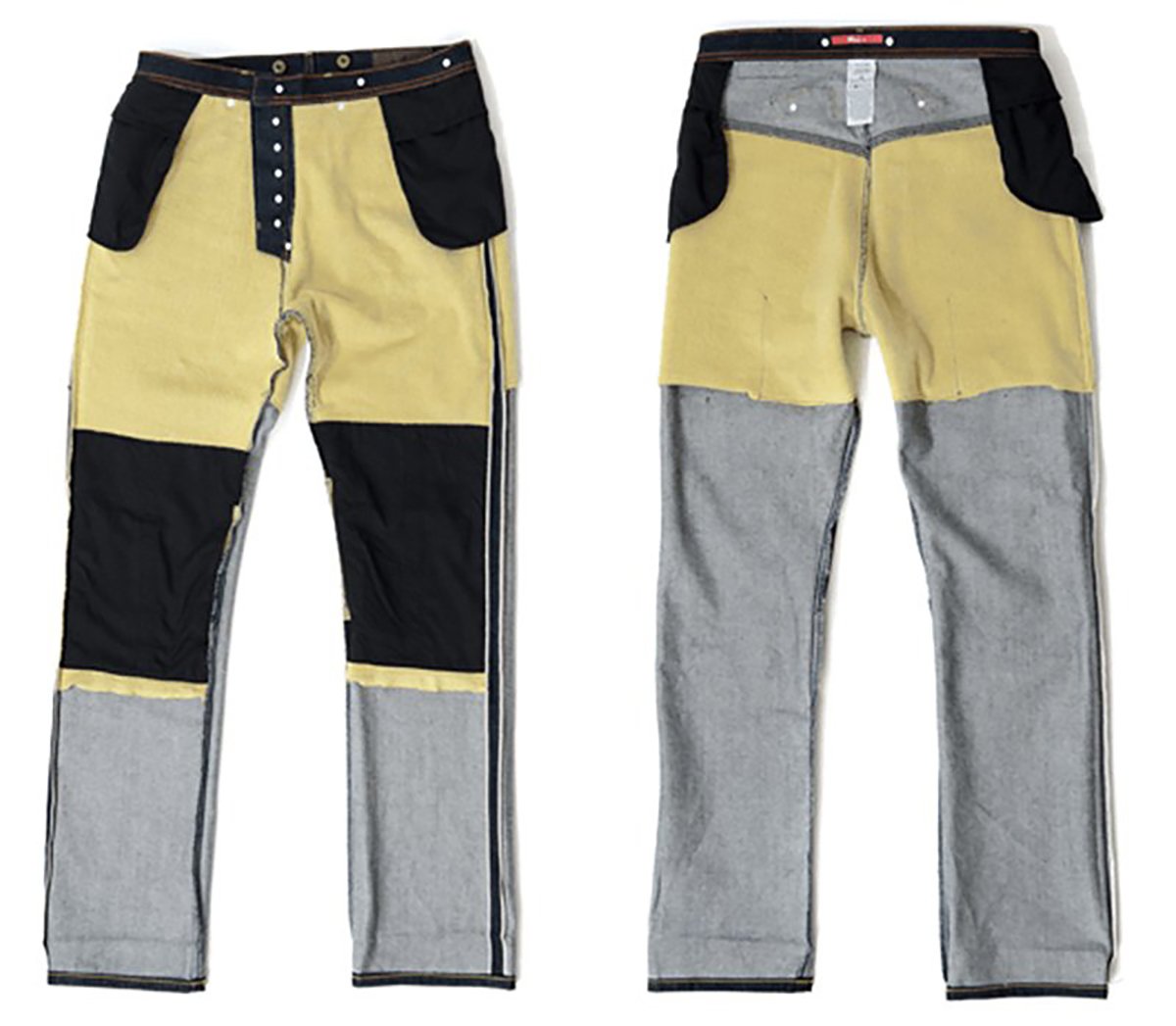
Now let me be clear about this; I’m using Kevlar® as the best known example of an aramid fibre. I do not intend any disrespect to DuPont®. And when I cite ‘Kevlar® jeans’, I am using this term as a shorthand for all aramid-lined jeans because, being the most prominent aramid fibre, most bikers will use the term ‘Kevlar® Jean’ in a generic sense to mean any jean with a protective lining. DuPont® has asked us to make this clear, and to also point out that Kevlar® single-layer jeans do also exist. We know this, of course, and indeed we do already sell Halvarssons’ single-layer Kevlar® jean, known as the Macan.
Kevlar motorcycle jeans
My point about ‘Kevlar’® or ‘lined’ jeans, is that in hot weather, such jeans will become sticky, sweaty and just a bit unpleasant. For most bikers, life will be more comfortable in what we call a ‘single-layer’ jean.
Let me go back a while; perhaps 25 years ago. I remember buying my first pair of protective motorcycle jeans from America. I was very excited about them; nobody I knew wore jeans on their bike. I thought that I looked really cool in them. Looking back, I now realise they were hideous. They lining was so thick and heavy I had to wear braces to keep them up.
I don’t think ’skinny’ was the fashion back then, but these pants must have been a foot wide. The thickness of the lining was about the same as the stuff you put in the roof for insulation. Which might explain why I could barely walk in them, and why my hot sweats were menopausal in their persistence and regularity.
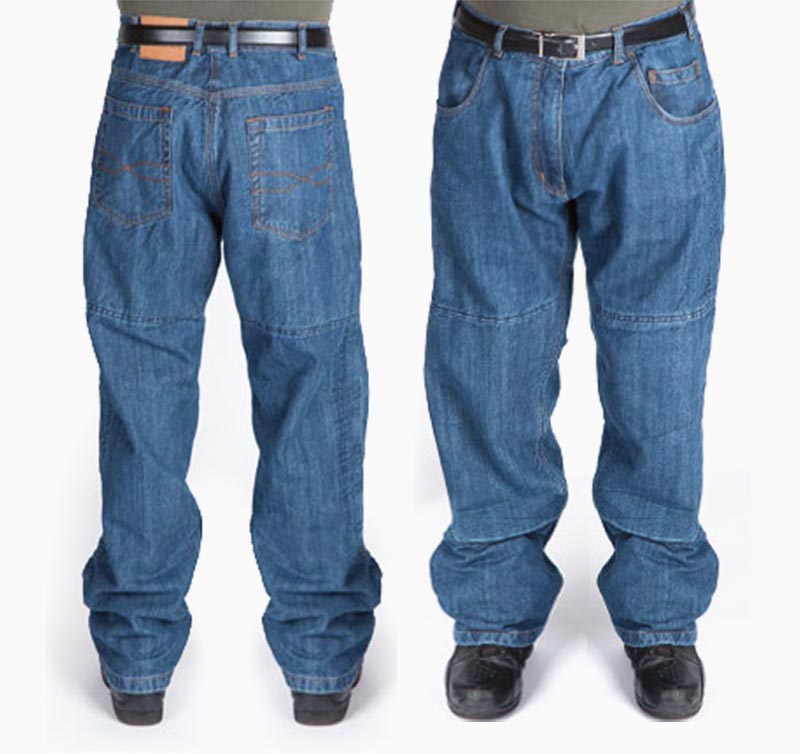
Best single layer motorcycle jeans
Today’s lined jeans are much better and much nicer to wear.
For the sake of clarity, let me clarify the whole Kevlar® thing. Kevlar® is a brand of aramid fibre. Weaves created from aramid fibres can be very strong. They don’t tear easily, they are puncture resistant, and they resist abrasion. There are, in fact, many different aramid weaves in the motorcycle market. Bullitt jeans use a weave called Covec, for example. Another one is Pekev, which is the name of the weave used by Resurgence. PMJ has one called Twaron.
The motorcycle industry has a test called the ‘Cambridge Test’ that measures abrasion resistance. A piece of material is lowered onto a sanding belt, and the time it takes for that material to wear through is known as a ’slide’ time. Not every manufacturer tests its jeans for abrasion; in fact, by far the majority do not. But it’s not unheard of for jeans to record slide times in excess of nine seconds. Now that’s impressive, because that’s twice as long as leather. And leather is way over the top for normal road riding. The slide time on leather is normally between 4-5 seconds.

Obviously not all lined jeans record such impressive times. It depends on the nature of the lining material but, importantly, you need to be mindful that some lined jeans are very sparsely lined. On many occasions in the past, we have simply refused to sell a lined jean because there was only a tiny slither of the lining in the bum. The only way you can ever tell how much protection a lined jean offers is to turn the jeans inside out, and see how far the lining goes.
Our particular, pet hate is those jeans that look like motorcycle jeans, and which have impact protectors in the knees, but which have no anti-abrasion lining at all. They’re actually 100% cotton. Thankfully, under the latest EN17092 regulations, it is unlikely that such jeans would be certified.
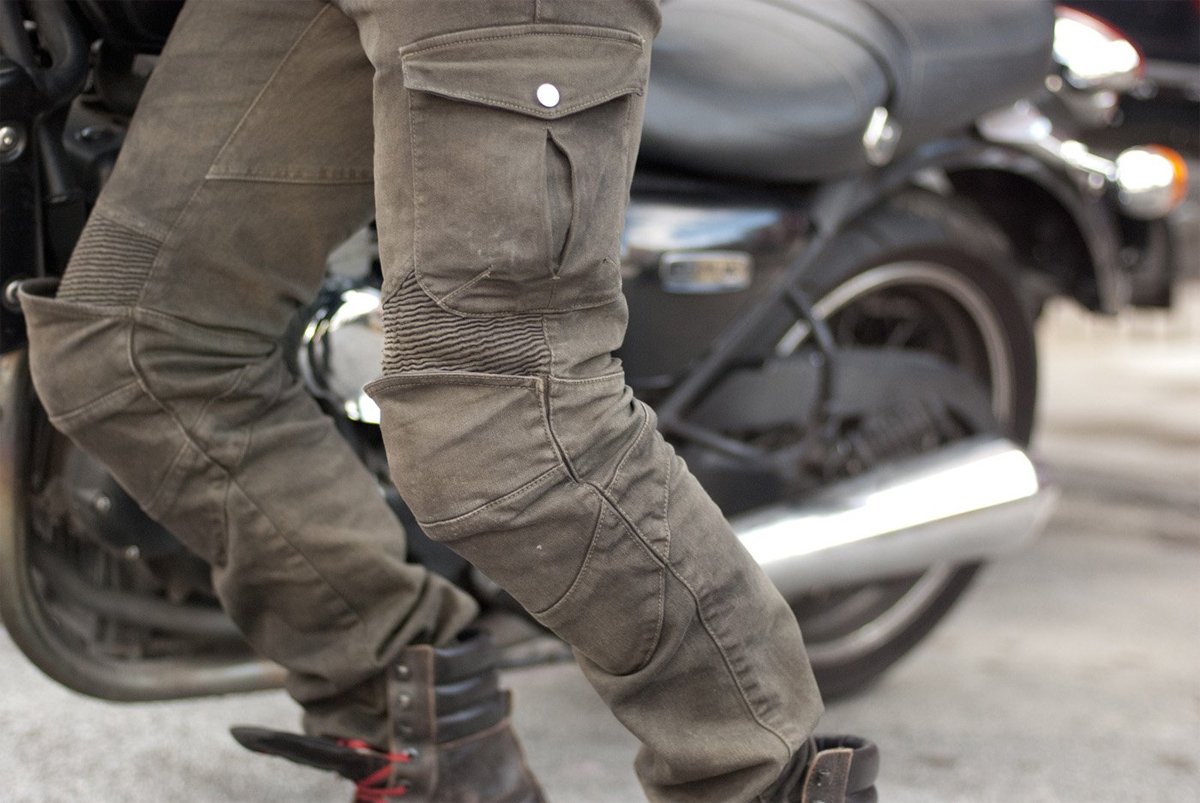
The problem with aramid-lined jeans is, by definition, that they are lined. And when it’s hot, or just very warm even, nobody wants to ride around in a lined trouser. Jeans that come 100% lined will be warmer usually than those with, say, a 60% lining, but both will make you warmer than you want to be. They’ll also make the jeans heavier, less breathable, and hence sweatier.
Now when the only alternative was a leather pant or a full-on motorcycle trousers, these jeans made a lot of sense. The good ones looked like a pair of Levi’s. You could walk around in them, and nobody was any the wiser. But now there’s an option, and it’s called a single-layer jean. In a single-layer jean, the strong fibre (an aramid, or a UHMWPE), is woven into the fabric. The warp (one direction) might be a cotton, but then the weft (the other direction) would be something a lot stronger, albeit perhaps woven in a sleeve of cotton.
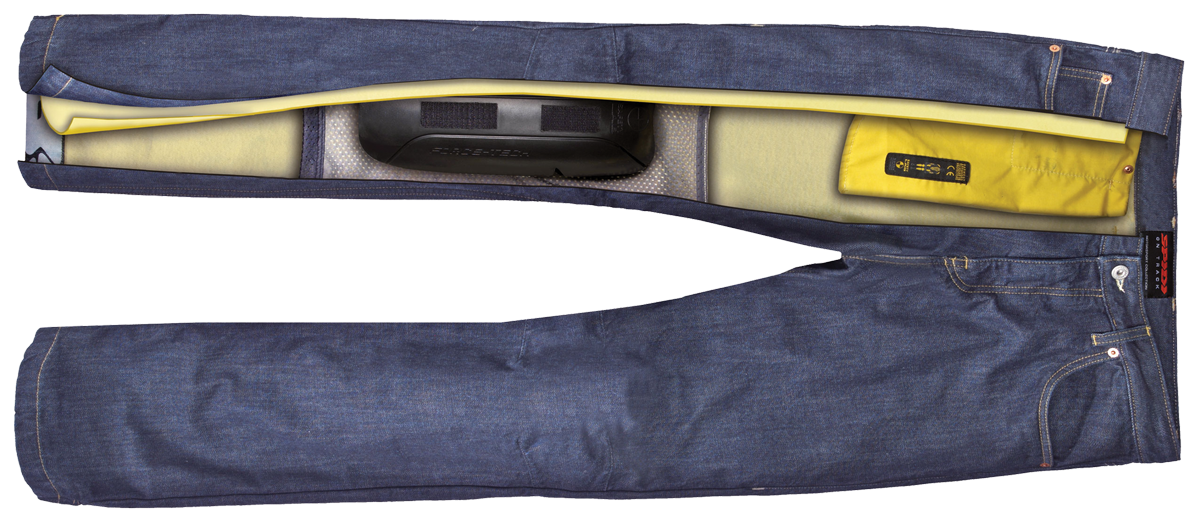
The main benefit of single-layer jeans is that they are much nicer, lighter and easier to wear. In fact, the best ones feel no different to a standard pair of jeans; just a bit sturdier perhaps. They won’t add bulk to your legs, and when you’re riding, they’ll flow the air more like a mesh pant than a traditional motorcycle trouser.
In fact, single-layer jeans in one form or another have been around for a number of years. The problem has been, though, that they weren’t historically always particularly strong. They would use a material like Cordura that would make them way stronger than shop jeans; but in truth they still weren’t up to the demands of serious motorcycling.
But as the technology has developed, so has the strength of the fibres used in jeans. Today, there are many options. They vary in style, price and strength and so, as a motorcyclist, it’s often difficult to know which are the most appropriate. So we thought we’d share with you what we know. Of course, we don’t have an intimate knowledge of all the brands of single-layer jean, although we have selected those we consider to be the best.
In our world, at the lower end when it comes to abrasion, are the jeans woven with a mix of cotton and Cordura. From Spidi in Italy, we do a jean called the J Tracker. It’s nicely styled, with a faded wash that is not overly aggressive. It’s very light, and really does not feel any different to a shop jean. But its official slide time on the Cambridge Test is just 2.1 seconds. In our view, that’s not enough for serious road riding.
Nobody wants to come off the bike, but if it happened at 70mph, I would want to be wearing something more robust. But if all you ever do is potter about on your Bonnie, or ride around town, then they may well be up to the job. And they’ll be sooooo much stronger and more protective than shop jeans, which will normally record less than half a second on the Cambridge Test. These jeans are not expensive, they come with knee armour only. They will be cool to ride in, they will be nice to walk around in, and they may be just what you’re looking for.
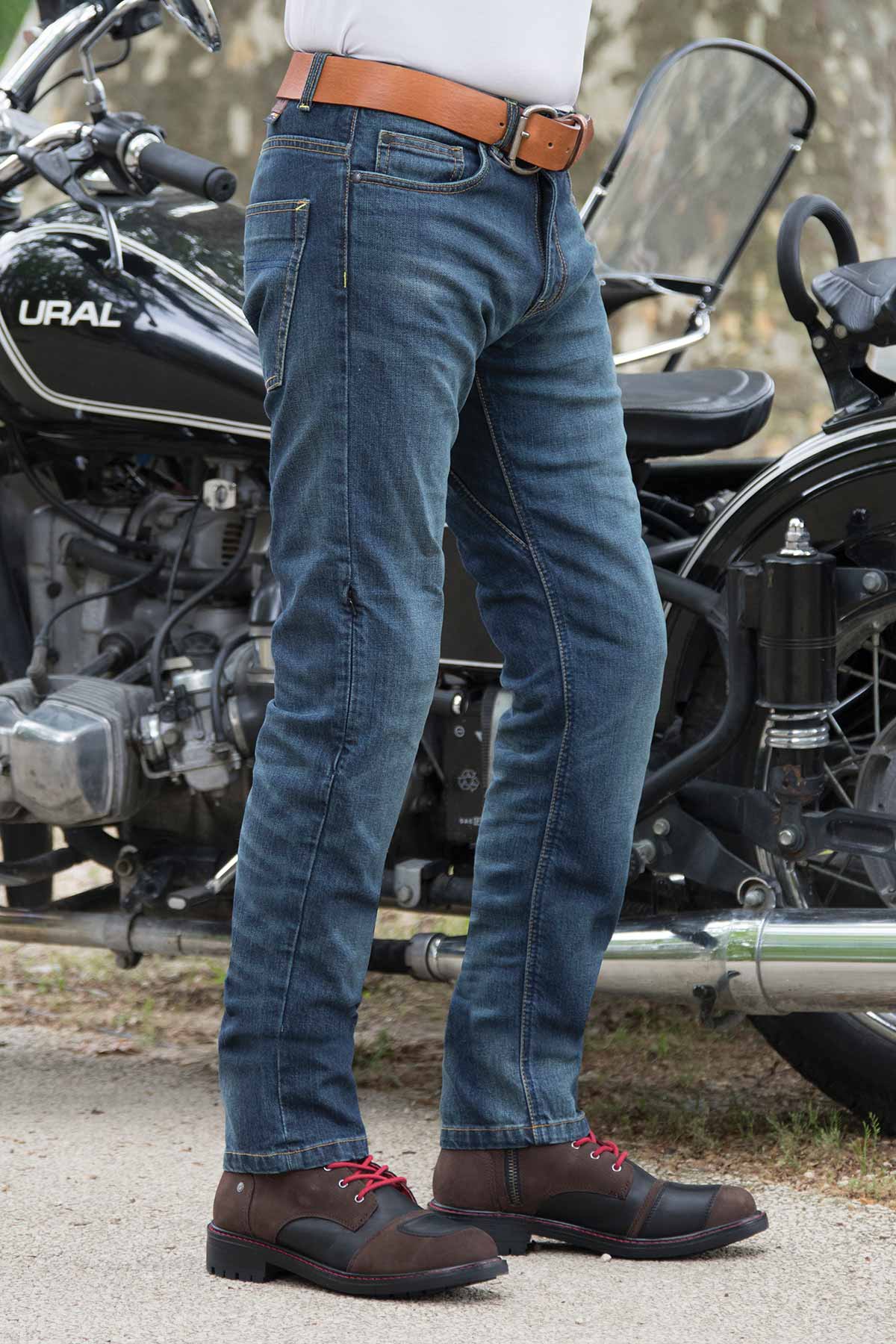
Aramid fibres tend not to be used in the construction of single-layer jeans, for a number of reasons. Halvarssons produce a single-layer jean called the Macan that is woven with aramid fibres. It’s a strong jean; it is AAA-rated under EN17092, and we would guesstimate that it delivers a slide time of around four seconds. It wears better than a lined jean, but it is still quite a heavy and thick jean. It is certainly not our favourite single-layer jean, although from a protection standpoint it is quite impressive.
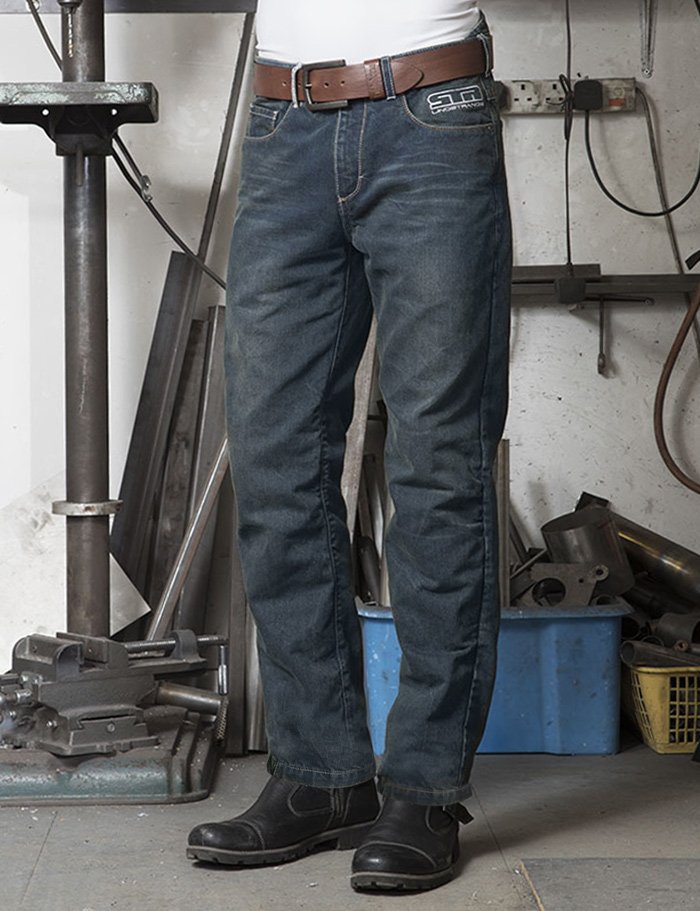
Spidi produces another single-layer jean. It’s called the J&Dyneema, and the fibre that is woven into the cotton is a material called, funnily enough, Dyneema. This is a brand name for a particular UHMWPE (Ultra High Molecular Weight Polyethylene). Dyneema is very strong, stronger than carbon steel, yet light enough to float on water.
In the Spidi jean, it delivers an official slide time of 4.1 seconds. Spidi calls the jean black. We call it a very, very, very dark blue. The cut is slim; the jeans look very stylish and come with knee and hip armour. They’re more expensive than the Halvarssons jeans. But the Spidis look great, they’re well up to the job on the road, they’re nice to wear, and if you want black (we still think they’re dark blue), these are certainly an option. They only come in a 32” leg, however.
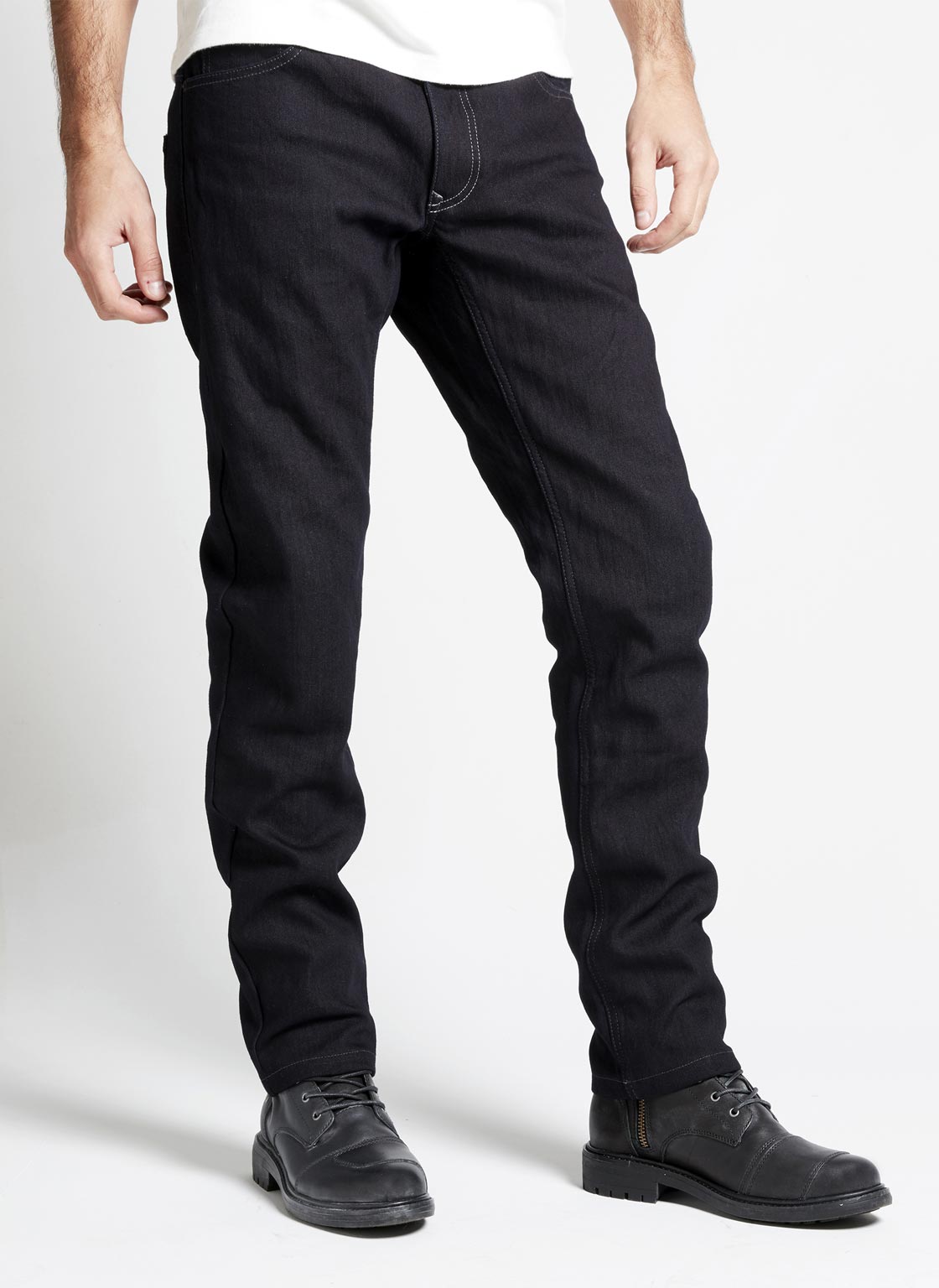
As I write this, the brand at the top of the single-layer tree is Swiss company Rokker. Their Revolution jean is made from Dynatec. Its USP is that the single-layer outer fabric has laminated to it a waterproof/windproof membrane known as C-Change, from Schoeller Industries. It makes the jean about as waterproof as any biking pant you’ve ever worn; even a Rukka pant. They have a loose-ish 501 fit but, in truth, because of the bonded membrane, they don’t wear quite like a regular denim; they’re a touch stiffer. But if that’s the price of a waterproof jean, so be it. They have a respectable 3.15 second slide time. They do have one weakness, though. When it’s really hot (high twenties and into the thirties), the membrane does impede perspiration.
They can get a little sticky. A pair off full-length, mesh pants will help a lot in this regard, but ultra warm days are not what the Revolutions were designed for. For the rest of the time, though, they’re simply brilliant. Especially, here in the UK where we’re no strangers to a bit of the wet stuff.
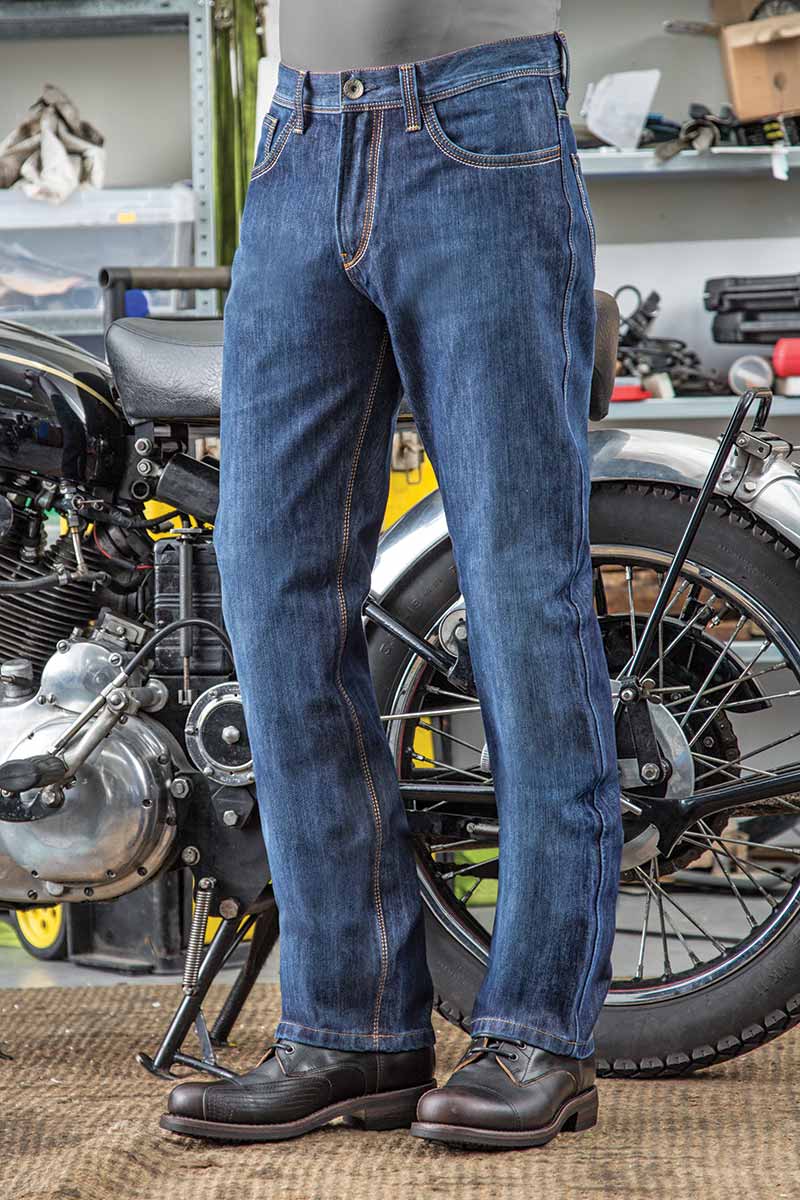
Another single-layer pant from Rokker is actually not a jean; it’s a chino. It’s a very smart trouser you could wear to the office. They come in khaki or in black. Obviously, they have pockets for armour, but they also happen to have an amazing slide time of 6.13 seconds, so are way better than leather. They’re not what we’d call lightweight, but you would be happy in them on all but the hottest of days. If you’re waiting to effect a slightly more formal look, or don’t want to wear jeans, Rokker’s chinos may be just up your street. They come in lots of waist sizes, and three different leg lengths.
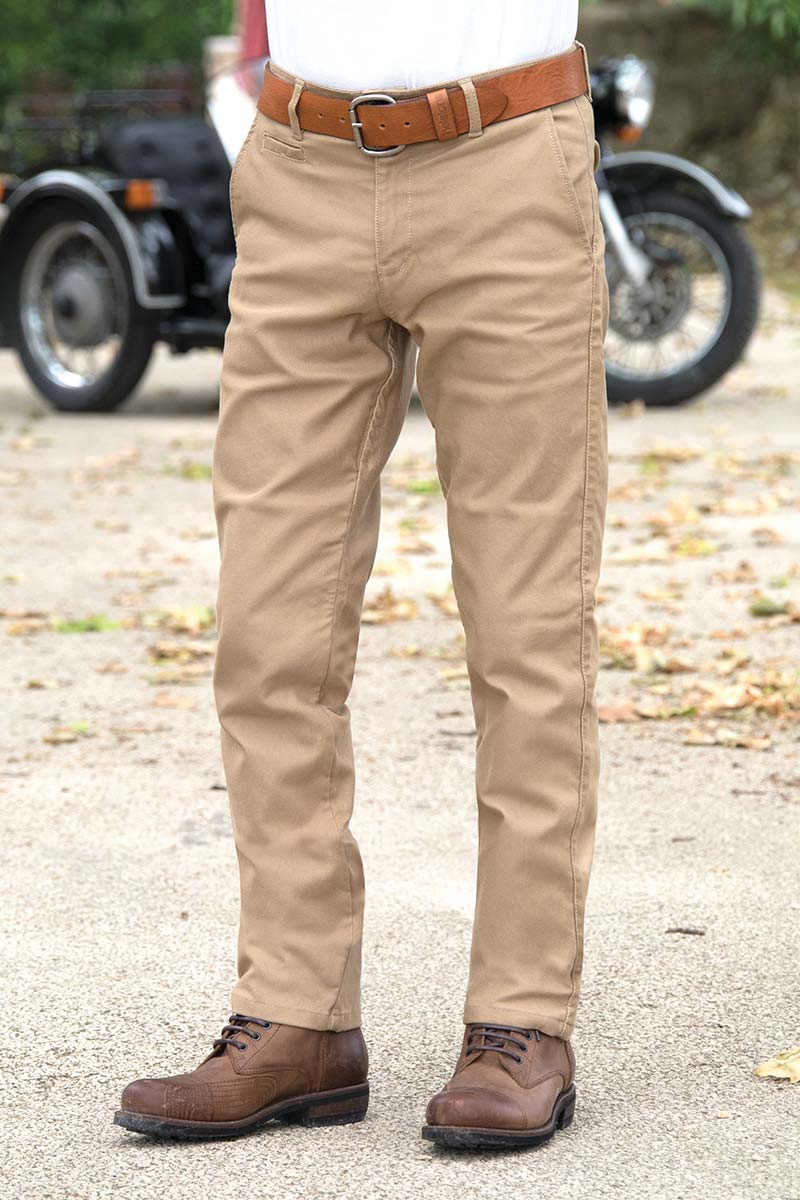
The most famous jean in the Rokker line-up is called the Rokkertech. They wear and feel just like a jean you’d pick up in a fancy denim emporium. They flow the air with abundance, and they have a slide time of 6.39 seconds. Which is way more than you’re ever going to need. We simply love Rokkertech jeans, and so, it would seem, do our customers. They fit really well, and always look flattering. Whenever anybody tries a pair on, all they can say is that they feel like a pair of jeans. The ultimate accolade, in our book. They come in a variety of washes, finishes and fits.
What we particularly like about the Rokkertechs is that they comes in 10 different waist sizes and four different leg lengths. There are very few people that don’t like the fit. Again, they’re not cheap, but for a jean that looks this good, and performs at such a high level, most people think they’re good value. At the time of writing, we can say with a degree of confidence that these are the finest, most comfortable, best looking, and toughest jeans money can buy.
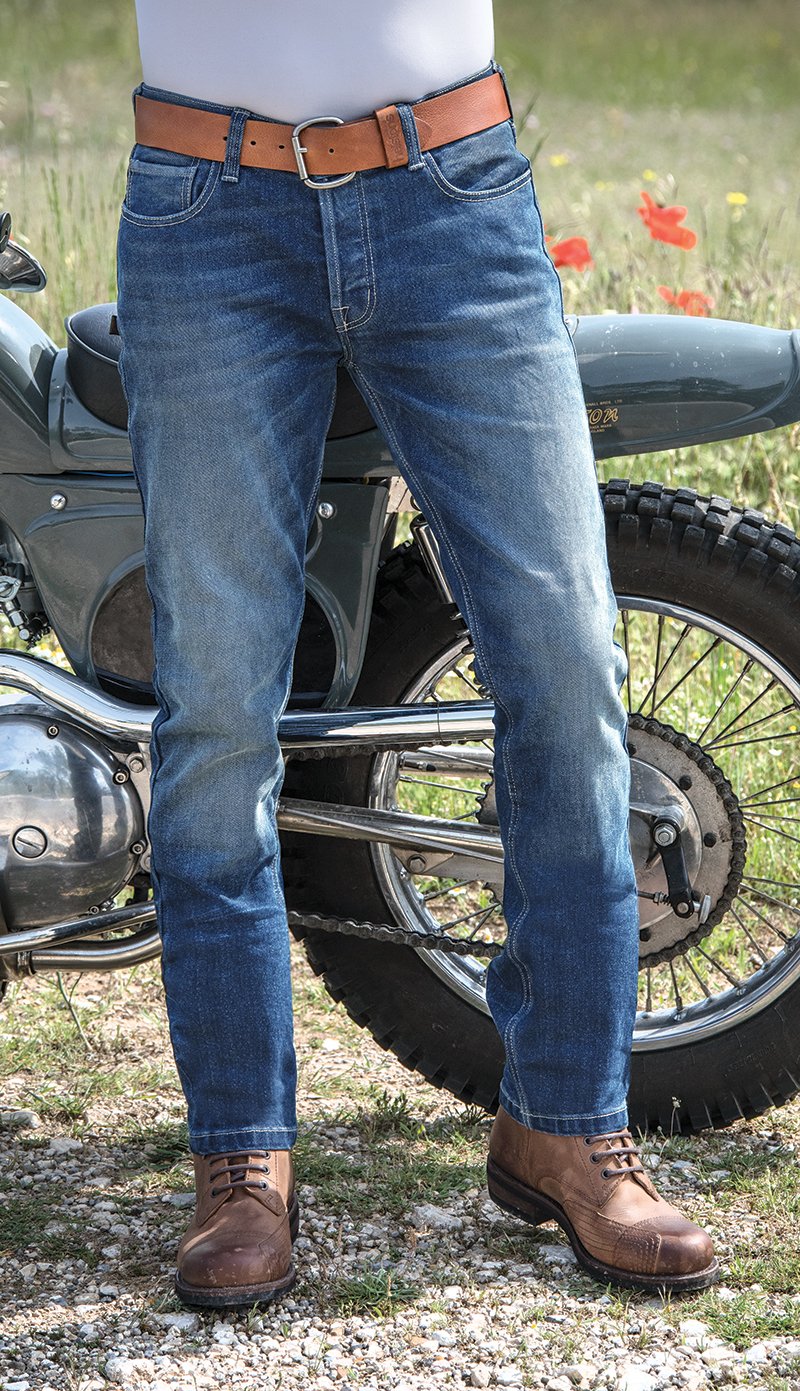
But there is another player in the single-layer market, the Italian brand PMJ. PMJ has developed an aramid fibre-based weave that is called Twaron. The company produce many lined jeans, but also a couple of single-layer jeans, the most impressive of which is called the Tex-Pro. The jean is incredibly light, yet attains the highest AAA rating under EN17092. They record a slide time under EN13595 of over four seconds. They are lovely to wear, and are more than reasonably priced.
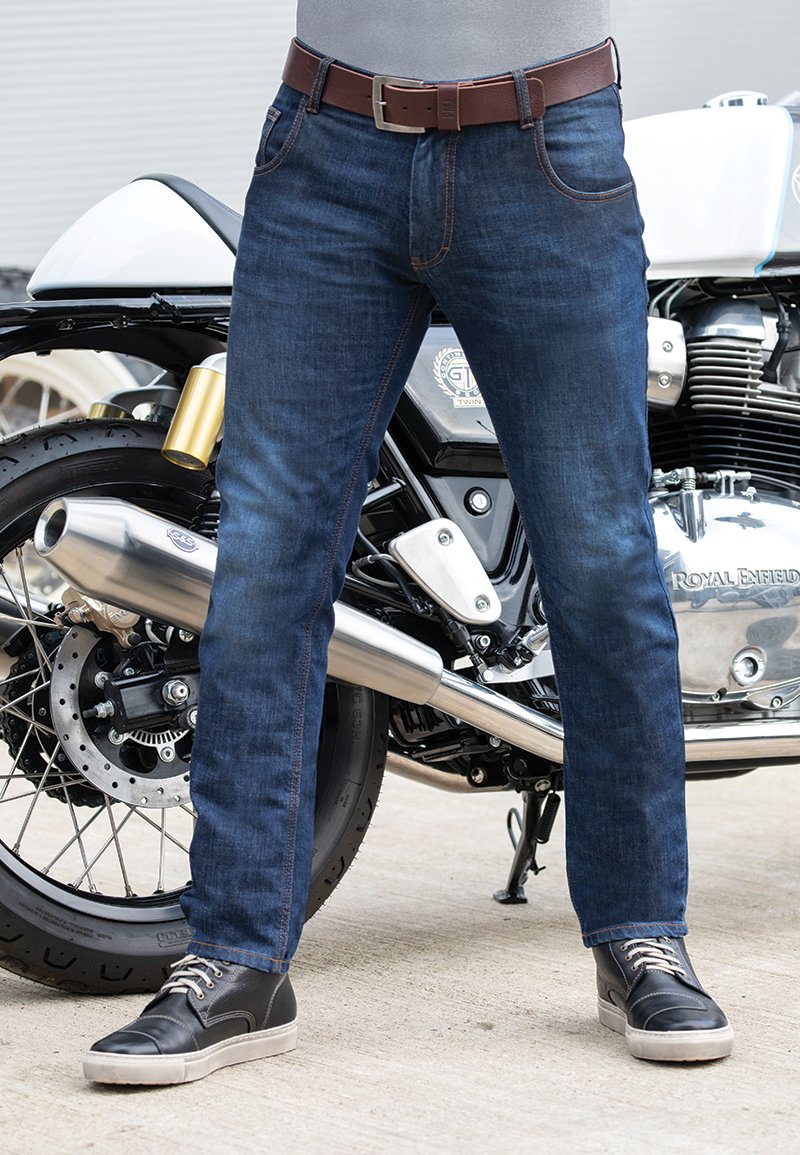
So there we have it. Our take on single-layer jeans. Given how far they’ve come in recent years, you will understand why we think you should no longer buy a traditional, lined jean. Single layer is where it’s at. Inside a couple of years, nobody will make lined jeans. And indeed we have taken the decision already not to sell traditional lined jeans. Frankly, we don’t see the point.
Share this story
































































